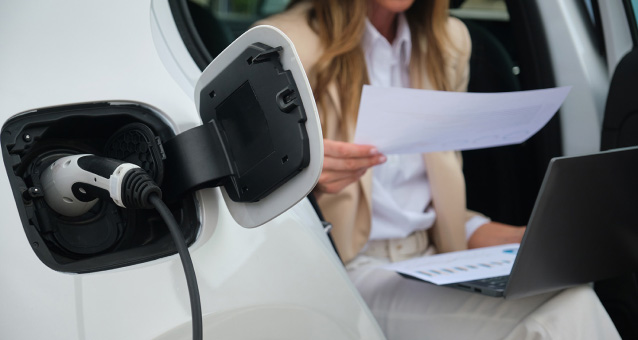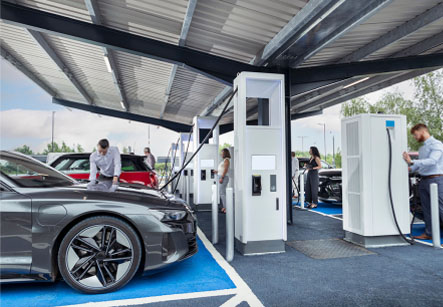Driving the transition to electric vehicles
Car manufacturers are coming out with a range of fully electric and hybrid electric models every year. We know these new vehicles present new and different questions for car buyers, and Chase Auto is here to help you navigate the quickly accelerating world of electric driving. Explore the latest tools and information to make the transition to an electric vehicle.

Types of electric vehicles






There are three types of car technologies that use the word “electric” – hybrid electric, plug-in hybrid electric and fully electric. These vehicles provide a range of options for consumers.
EV tools & resources
The latest on EVs
from Chase Auto
Frequently Asked
Questions
Most EVs on sale in the U.S. have over 290 miles of range, with about 6% of them having over 400 miles of range. Same page link to footnote reference 1 With more than 71,000 public charging stations across the United States as of February 2025, simple commuting and long-distance travel are both possible in most electric vehicles. Same page link to footnote reference 2
There are more than 71,000 public charging stations in the United States. Most are concentrated in highly populated urban areas, but there are public charging stations available in all 50 states. Same page link to footnote reference 2 To find chargers when planning your next road trip, use this mapping tool that will show you all chargers on your route along with real-time availability.
The median range of EVs released in 2025 is over 290 miles, with about 6% of them having over 400 miles of range. Same page link to footnote reference 1 If you run out of power in an electric vehicle, the car will simply stop moving. The electric vehicle can be towed to the nearest charging station just like a gas-powered car is towed to a nearby gas station. Same page link to footnote reference 3
An electric car will add approximately $70 to your monthly electric bill. Same page link to footnote reference 4
Electric vehicles tend to cost marginally more to insure than equivalent gas-powered cars. That’s largely because electric vehicles are typically pricier to both buy and repair. Same page link to footnote reference 5
As of January 2025, the average transaction price of a new electric vehicle was $55,614. This compares to $48,641 for the average price of a new gas-powered car purchased in the U.S. Same page link to footnote reference 6
There may be rebates and discounts offered by your state, local municipality, or local electricity provider. These may include additional rebates off the cost of the car, rebates on home charging systems, discounts on electric charging rates or perks like preferred parking or carpool lane access. Discover the savings you may be eligible for using this incentive look-up tool.
In the U.S., the average cost of a kilowatt of energy is approximately $0.1317. Same page link to footnote reference 7 If you drive 1,000 miles a month, the cost to fuel your electric vehicle will be just under $38.
However, the cost to charge an EV is dependent on many factors, including your location, vehicle and power source. Charging at home and charging with a public charger also have different costs.
Chase provides financing for a wide range of vehicles, including both electric vehicles (EVs) and plug-in hybrid electric vehicles (PHEVs). Financing for EVs and PHEVs can optionally include the cost of EV charging equipment for your home.
To get started, go to chase.com/autoopens ina new window.
The short answer is no, EVs can be charged anywhere you can find an outlet. However, for people living in multi-family housing, home charging will require additional planning.
As electric vehicles continue to become more common, property managers are more likely to offer home charging options for residents driving electric vehicles. EV drivers can discuss with building management the practicality and possibility of installing shared charging equipment on building grounds. Some states and cities offer programs that will help cover the costs associated with the installation of shared charging in multi-family parking lots, and strategies such as assigned parking for EV owners can make home charging convenient and easy for residents. Same page link to footnote reference 8
Other options for EV owners without a garage include finding a supercharging station close to home, charging at a location close to work, or working with your employer to coordinate a charging station on company grounds.
EV maintenanceopens in a new window costs are typically lower than conventional automobiles. EV owners who drive 15,000 miles per year could save approximately $6,000 in repair and maintenance costs over a 5-year period compared with a gasoline-powered car. Same page link to footnote reference 9
Selecting a repair shop for electric vehicle repairs depends on the make and model of the car and the nature of the issue. For standard repairs such as rotating tires, inspecting the suspension, or replacing cabin filters and wiper blades, any local shop can be of service. However, for issues relating to the EV battery or other EV technology, the vehicle should be taken to a local dealership or other qualified mechanic.
PHEVs are Plug-in Hybrid Electric Vehicles, and they have both a gas-powered engine and an electric motor that is charged by plugging it into an outlet. Same page link to footnote reference 10 Some PHEVs operate on electricity until the battery is nearly empty, and then switch over to their gas-powered engine. Other PHEVs—sometimes called “blended mode” PHEVs—use gasoline and electricity simultaneously to power the vehicle while the battery has charge. Either way, PHEVs are able to run on gasoline alone, even when the electric battery is fully depleted.
Sources
This content is for educational purposes only and provides general auto information. The material is not intended to provide legal, tax, or financial advice or to indicate the availability or suitability of any JPMorgan Chase Bank, N.A. product or service. Outlooks and past performance are not guarantees of future results. Chase is not responsible for, and does not provide or endorse third party products, services or other content. For specific advice about your circumstances, you may wish to consult a qualified professional.















